Samsung Series 8 UE46B8000 – 46in LCD TV Review
Samsung Series 8 UE46B8000 – 46in LCD TV
John takes a look at the top of the range version of Samsung's ultra-thin LED backlit TV range, the UE46B8000.
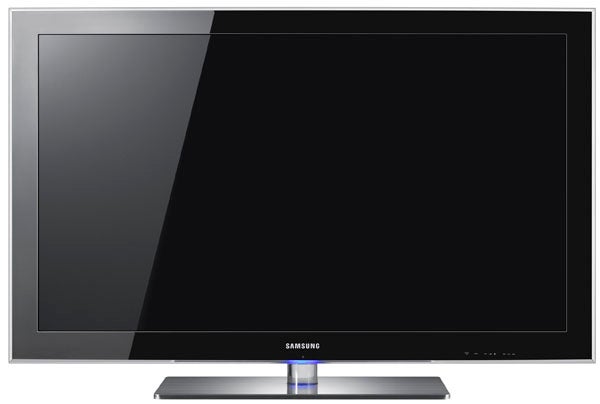
Verdict
Key Specifications
- Review Price: £1750.02
Samsung isn’t the UK’s biggest selling TV brand for nothing, you know. For, in another display of the sort confidence – bordering on bravado – and vision that’s left its rivals trailing, Samsung has this year launched not just a couple of TVs using LED backlighting, but a whole new category of LED TVs, comprising no less than three different ranges. And, rather excitingly, it’s a model from the highest of these three ranges, the B8000 series, that I’ve got my hands on today.
At 46 inches, UE46B8000 certainly looks every inch a flagship TV. For a start it’s astoundingly slim – less than 30mm deep off its stand, in fact. Samsung’s addition of a clear, centimetre-wide prism beyond the edges of the screen’s glossy black, ultra-minimalist frame also looks divine, as does the transparent ‘neck’ that joins the TV to the included (though not pre-attached) metal desktop stand. 
As if all this wasn’t already opulent enough, Samsung has also conjured up a special wall mount bracket option for the B8000 series that reduces the gap between the TV and your wall to just 0.6in, while using just a single screw. Impressive.
Making the extreme slenderness of the set all the more remarkable is the fact that unlike most ultra-slim TVs, it has somehow managed to squeeze both analogue and digital (Freeview) tuners into its svelte form.
There’s even a huge connections roster – removing the need for an external tuner/switching box – with highlights including four HDMIs, two USB ports (one impressively capable of working with USB HDD devices) and a DLNA-certified Ethernet port capable of bringing in multimedia files from your PC or other DLNA-certified storage devices. Chunky SCART connections are also supported, albeit only via a provided adaptor that takes the traditional SCART end and converts it into something a whole lot more slender.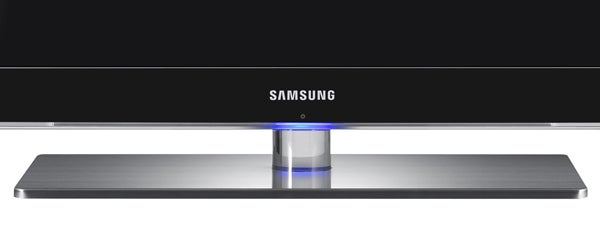
However, Samsung’s decision to include all the necessary connections and tuners within the B8000’s main body rather than using an external multimedia box won’t suit everybody. After all, it means that you’ll have to either suffer or hide reams of cables spooling out of the TV’s rear, rather than just having a single cable like you get with, say, the Philips Essence TV. This cable spaghetti could be especially troubling for people wanting to hang this set on the wall.
Given how few of us ever actually get round to wall-hanging our flat TVs, though, I have a sneaky suspicion that the B8000’s ‘everything built in’ approach will win it more friends than enemies.
With the set’s glamorous exterior covered, let’s now turn our attentions to its interior, starting, of course, with the key LED backlighting.
LED lighting in LCD TVs has repeatedly been proven to deliver a number of different advantages over the standard LCD single CCFL backlight. Much deeper black levels, improved motion reproduction, much larger contrast ratios and the potential for much slimmer screens are all associated with LED backlighting.
Samsung is very keen to stress the green credentials of the B8000 series, too. Apparently the LED lights burn as much as 40 per cent less power than standard LCDs. What’s more, LEDs are also mercury free and the set’s on-screen menus contain a mode that adjusts the backlight output and other picture settings in response to the light levels in your room.
In fact, Samsung is so proud of the B8000’s green credentials that if you press the remote’s info button, you get a little dial-like reading suggesting how much more efficient it is being at any given moment compared with a standard LCD TV. Though, without any actual voltage measurements on this dial, it’s hard to see how it has any real, provable significance other than as a marketing tool for a cheeky salesman to use.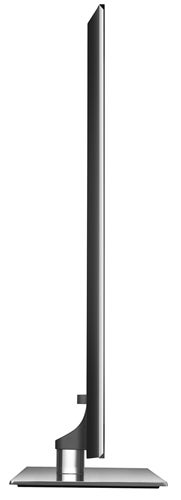
At this point things are going to have to get slightly complicated for a minute or two because, what you might not realise, is that there are actually two types of LED backlighting. The most common one just positions ‘sectors’ of LED backlights in an array directly behind the screen, with each LED sector being individually controllable. This level of control allows for ‘local dimming’, whereby each part of the LED array can have its light level independently set to suit the demands of the image being shown, resulting in the potential for almost totally dark image sectors to sit right alongside extremely bright ones in a way just not possible with a single CCFL backlight.
The other LED approach is to position the LED lights around the screen’s edges, so that they shine their light across the screen’s rear rather than through it from behind. This approach allows screens to be built much slimmer than ordinary LCD or LED TVs – as proven by Sony’s 9.9mm deep 40ZX1 TV. Unfortunately, though, if you go for the edge-mounted LED approach, you lose the key local dimming advantage.
However, while this state of affairs has led to edge-mounted LED lighting traditionally being considered a design-led picture quality compromise, Samsung boldly claims that the edge-based system inevitably found in the Ultra-Slim UE46B8000 actually produces better picture quality than a normal rear-mounted array.
For instance, although you can’t have local dimming with edge-mounted LEDs, Samsung claims that the more generalised dimming properties possible with this system can actually producer greater contrast results – and faster dimming response time – than local dimming engines.
What’s more, Samsung also claims that its ultra-slim LED engine can produce greater image uniformity and higher brightness than standard LED engines, not least because ‘direct’ LED engines use a darker diffuser mechanism than edge-mounted LED systems in order to boost uniformity. And this darker diffuser, says Samsung, loses 20 per cent of brightness compared with its LED engine, which in turn leads to direct LED TVs using up to 20 per cent more power to achieve the same brightness levels as an ultra-thin model.
In fact, Samsung claims that its ultra-slim LED arrangement is as much as 30 per cent more energy efficient than direct-lit LED TVs, a fact which helps edge-mounted systems also enjoy a supposed 40 per cent greater life span.
Finally – and perhaps most cheekily – Samsung claims that while a direct, RGB LED TV can produce a wider colour gamut than an ultra-slim LED TV, this isn’t actually very helpful to producing a natural colour from the colour maps associated with our main video standards. In other words, by being closer to the colour map of our video standards, Samsung says that its ultra-slim LEDs won’t be as likely to suffer over-saturated reds and greens as a direct RGB LED set like Sony’s X4500 models.
All very interesting. And the proof of the pudding, of course, will be in the eating. But, before we get to that, while we’re focussing on the UE46B8000’s physical construction, I can also report that it uses the same Ultra Clear Panel technology used to great effects on most of Samsung’s ‘normal’ LCD TVs. This uses a proprietary anti-reflective coating within the screen’s construction to boost contrast and colour response by reducing the amount of ambient light that hits the screen.
Another extremely important feature of this set is its 200Hz processing engine. As with similar systems witnessed on Sony and LG TVs, this refreshes the picture four times as often as a standard PAL 50Hz TV by interpolating new frames of image data designed to ‘fill in the gaps’ between the real images coming in from a source – hopefully resulting in a picture free of judder and motion blur.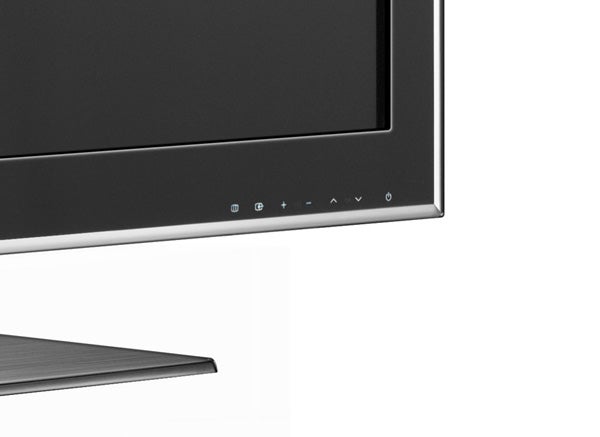
More good news finds countless other subtle picture tweaks tucked away within the nicely presented, if rather bizarrely organised, on-screen menus. I don’t see much point boring you with all of them here, though – especially as I’ll be getting into the most useful/interesting ones later on when we get to the picture quality portion of the review.
Before settling down to see what the TV’s capable of, though, I need to point out that as with all of Samsung’s recent mid and high-end TVs, the UE46B8000 is compatible with Samsung’s rather nifty online service, accessed via the Ethernet port or an optional wireless dongle inserted into one of the USB ports. Unlike similar systems from rival brands, Samsung’s online service genuinely has quite a bit of content to get your teeth into, including YouTube, Flickr and Yahoo news, weather and financial reports. What’s more, the TV also enjoys Samsung’s currently exclusive (until September) deal with Yahoo Widgets, making the addition of extra services relatively straightforward.
Adding still further to the prodigious multimedia potential, meanwhile, is another unique Samsung feature: the Content Library. This refers to a diverse selection of resources – recipes, children’s stories, photo screensavers and so on – pre-loaded into built-in flash memory. You can even add extra content to the library as and when Samsung makes it available from its website. Though to be brutally honest, my feeling with the Content Library is that it’s something you might explore a bit for the first few days you own the TV, but seldom go back to thereafter.
First impressions of the B8000’s picture quality with two of our favourite HD sources of the moment (Dead Space on the Xbox 360 and the Blu-ray of Quantum of Solace) were almost unbelievably disappointing. Both suffered from black levels that looked unexpectedly washed out and – shudder – deeply uneven across the screen, with the edges of the picture tending to look much brighter than the middle. Yikes. Suddenly Samsung’s extravagant claims for its edge-based LED lighting were starting to look very stretched indeed.
Thankfully, though, it quickly occurred to me that Samsung has a nasty habit of shipping its TVs using the most rubbish presets imaginable. And this proved to be the case with the UE46B8000 – with knobs on. Though, just to keep me on my toes, the solution to each source’s black level problems was quite different.
With Dead Space, the single most important change was to adjust the screen’s ‘HDMI Black Level’ setting from Normal to Low. With the greyness clouding, the nightmarishly dark corridors of the infested space ship suddenly turned into something you could genuinely called black, while the uneven backlight became all but non-existent. Now, at last, I was wrestling with the monstrous alien mutations and my own nerves rather than murkiness caused by the TV’s initial backlight flaws.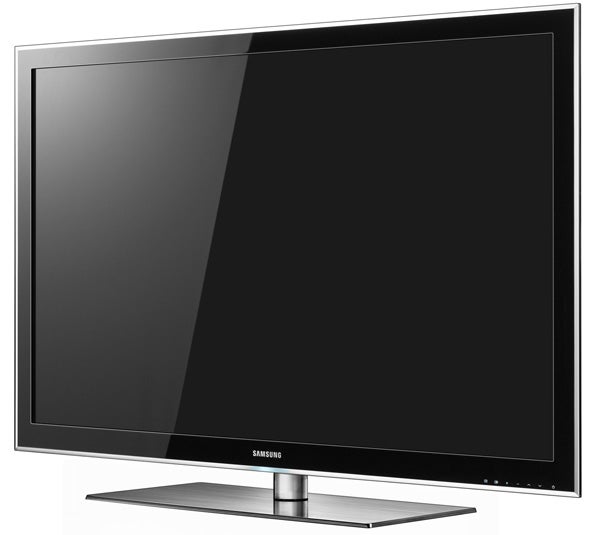
Also helpful in turning the set from zero to hero in the gaming black level department are the Backlight level adjustment (I personally would leave it set no higher than four for HD gaming) and the Black Tone adjustment (which I set to Dark).
You also need to adjust the TV’s image preset option from the horrifically over-aggressive Dynamic factory preset the TV ships with to a Game preset (weirdly tucked inside the TV’s Setup sub-menu rather than the main picture one!), before tweaking the game settings for better black levels in the ways discussed a moment ago.
You can, if you wish, achieve many of the same picture characteristics found with the Game setting if you just use the picture’s main Standard preset. However, the game mode crucially also takes much-needed measures – including deactivating the 200Hz engine – to reduce lag between a source signal arriving at the TV’s inputs and it then appearing on-screen. Fail to use the Game mode while gaming and your performance will very likely diminish. You have been warned!
Turning to the TV’s HD movie black level problems, the first thing to say is that oddly the option to adjust the HDMI Black Level is greyed out and can’t be used while watching a Blu-ray. Thankfully the black level problems aren’t nearly so bad to start with as they were with our Xbox 360, so pulling down the backlight (I personally went as low as its ‘2′ setting!), setting the Black Tone to Dark, keeping brightness to below 50 and reducing the contrast to below 85 got black levels looking pretty much as good as I might have hoped for and certainly way better than anything you’d get from the vast majority of standard LCD TVs.
In fact, pictures really do look as dynamic in contrast on the UE46B8000 as they do on the best backlit LED TVs. What’s more, the edge-based LED system seems to have largely eradicated the haloing around bright objects noted with last year’s Samsung LED models – or most other ‘direct’ LED models, come to that.
With my initial black level issues – and concerns about the edge-based LED system – finally seen off in fine style, it’s finally time to turn to other aspects of the UE46B8000’s pictures. And, once again, it delivers the goods in mostly stunning fashion.
Its Full HD resolution, for instance, is put to grandstanding use in reproducing HD pictures with mesmerising amounts of fine detail and texture. Yet, provided you avoid the overwrought Edge Enhancement option, it produces its sensational detailing without making the images look gritty or harsher than they should.
Image sharpness is bolstered, too, by some really impressive motion handling. Panning around the game environment in Dead Space, for instance, reveals markedly less judder and blurring than we tend to see with standard LCD TVs – even though no 200Hz is in play with the Game mode active.
I’d certainly recommend using 200Hz for movie viewing, though. For it proves extremely adept at reducing both motion blur and judder – even with 24p sources. Just make sure you stick with the ‘Clear’ 200Hz sub-option, as picking the Smooth or Standard 200Hz presets invariably results in a few too many processing glitches, such as flickering over really fast motion, or shimmering halos around slower, larger portions of movement.
It’s also worth experimenting with the thoughtful ‘custom’ 200Hz setting, which allows you to adjust the processing’s impact on blur and judder to suit your own tastes, using simple sliding scale interfaces.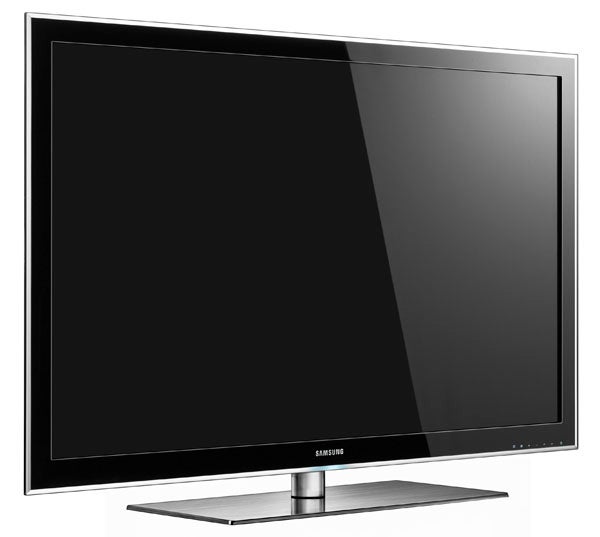
The UE46B8000 also does a great job with colours. The range, naturalism and subtlety of its colour palette goes some way beyond what most non-LED LCD TVs can produce, with perfect, stripe-free colour blends, credible and consistent skin tones, and no apparent taste for ‘pushing’ any particularly primary colour ahead of the rest.
Yet more good news finds the UE46B8000 handling standard definition sources really very well. Extra details are added during the upscaling process without unduly emphasising any source noise, while colours retain their natural tones rather than some tones sliding off key as so often happens during the rescaling process. Again, though, I’d recommend that you use the HDMI Level Low setting while watching a Sky receiver.
This impressive standard definition state of affairs is actually a slightly unexpected discovery given that other Full HD Samsung flat TVs generally only rate as solid in the standard definition department. Not that I’m not complaining.
My only complaints with the UE46B8000’s pictures, in fact, once I’d worked past the daft preset situation, would be that their post-calibration brightness levels aren’t particularly high and that patches of subtle backlight inconsistency can creep into the image’s edges if you have to watch the TV from much of an angle.
Turning to the set’s sound production, I wasn’t particularly impressed. As with many of Samsung’s recent flat TV output, there’s nowhere near enough bass around to do movies proud, leaving action scenes and thumping scores sounding thin and unconvincing. This lack of bass also leaves trebles sometimes sounding a bit over-emphasised and harsh. The TV’s mid-range is, at least, open enough not to sound crowded during 90 per cent of your TV viewing.
Verdict
Despite initial concerns that the UE46B8000’s edge-based LED lighting might heavily compromise the TV’s picture quality in the name of nothing more substantial than a little extra design slimness, as well as another set of dismal image presets, this is a TV to be reckoned with.
Indeed, after a bit of initial recalibration and in the right room conditions, its pictures actually seem to back up Samsung’s claims that edge-based LED lighting is potentially a superior picture quality technology to direct RGB LED lighting. And I don’t mind admitting that nobody could be more surprised about that than me.
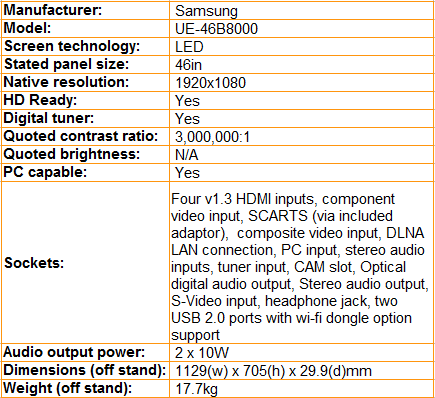
How we test televisions
We test every TV we review thoroughly over an extended period of time. We use industry standard tests to compare features properly. We’ll always tell you what we find. We never, ever, accept money to review a product.
Trusted Score
Score in detail
-
Features 9
-
Value 9
-
Image Quality 9
-
Design 10
-
Sound Quality 6
Features
| Size (Inch) | 46in, in |
| Display Type | LCD |
| Max. Resolution | 1920 x 1080 |
| Digital Tuner | ATSC |
| Contrast Ratio | 5,000,000:1 |

